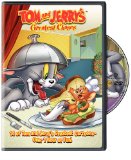In the 1930’s and 40’s MGM was trying to get in on the lucrative animation game. The field was dominated at the time by Warner Brothers with their Loony Tunes shorts, and of course, the iconic cast of animated characters coming out of the Walt Disney Studio. For years they had failed to find the right property to take advantage of the market. It wasn’t until the team of William Hanna and Joseph Barbera approached the studio with their first project that the times did change, at least a little, for the fledgling animation department at MGM. The project was far from an original one even for the time. It was a very basic cat and mouse adventure featuring a cat named Tom and a mouse named Jerry. There would be almost no dialog on the shorts. It certainly didn’t look like much of a hit to the studio brass, but with no better ideas on the way, they went ahead with the new shorts of Tom And Jerry. There’s a reason why the cat and mouse pair is such a classic. It’s because it works. If you can make your characters entertaining and endearing enough, you can have a hit. MGM finally entered the major leagues, and the team of Hanna and Barbera would become one of the most successful animation teams in history. They would go on to create such cherished characters as The Flintstones, Yogi Bear, The Jetsons, and, of course, Scooby Doo.
These were the days of the Golden Age in Hollywood. These shorts were not being produced for television, which hadn’t been invented when they began; rather, they were intended for theater goers. In those days going to the movies was much more of an inclusive experience. You always got a cartoon short along with an adventure serial, the likes of Buck Rogers, Flash Gordon, and The Lone Ranger. These multi-chaptered serials were the forerunners to the modern television series. It kept you coming back to the movies to see what would happen next. Each chapter ended in a cliffhanger. These early serials were the inspiration for such film franchises as Star Wars and Indiana Jones. Finally you got one, sometimes two movies, all for the price of a single admission.
Then came television, and suddenly entertainment was available in your living room for the cost of a set. It hit the movie industry hard, and cutbacks had to be made. Over the span of a couple of decades the films eventually appeared alone. Serial and animation production was winding down. MGM was hit about as hard as any other studio, and before long Tom And Jerry were on their way out. But television did much to save the cat and mouse duo.
Collected here you’ll find 14 of Tom and Jerry’s best providing over an hour of crazy antics.
Cat Napping (1951) Hammock Hammock Who’s going to get the hammock. The duo fight over the lazy summer sleeping spot.
The Flying Cat: (1952) Jerry is hiding out in a canary cage with the bird occupant. Tom is determined to get to them both.
The Two Musketeers: (1952) In Old England Tom is charged with protecting the King’s banquet table. A certain little mouse and his friends have other plans for the feast.
Smitten Kitten: (1952) Jerry has visions of all of Tom’s failed relationships when he falls for yet another female feline.
Baby Butch: (1954) Butch the dog is getting desperate for some munchin’ time. When all of his attempts to swipe some goodies fail, he makes himself up as a hungry baby in the hopes of getting fed.
Designs On Jerry: (1955) Tom hopes to build a better mousetrap.
Pecos Pest: (1956) When Uncle Pesco visits Tom with his guitar playin’, Tom’s not quite so happy. You see, every time Pesco breaks a string, he grabs one of Tom’s whiskers to replace it. Unfortunately, Pesco breaks a lot of strings. Fortunately, he’s not playing a catgut string guitar.
The Flying Sorceress: (1956) Tom gets a job as a witch’s familiar. He steals his boss’s broom to try and give Jerry a fright.
Blue Cat Blues: (1956) Tom’s sittin’ on the railway cryin’ over his latest lost love. Jerry sings the blues and tells us how it all happened.
The Night Before Christmas: (1941) The cat and mouse chase takes the pair out in the snow where the tit for tat gets really cold.
The Bowling-Alley Cat: (1942) It’s Tom’s night out to bowl, but he’s not aiming for the pins. He wants to nail Jerry with that big old bowling ball, but the only one who gets run over is Tom.
Fine Feathered Friend: (1942) Jerry might not be chicken, but he’s hiding out in the hen house. These ladies show Tom the pecking order.
Puttin’ On The Dog: (1944) Jerry’s hanging out at the dog pound with Spike. Jerry decides to disguise himself as a dog to get in.
Touché’ Pussy Cat: (1954) Nibbles wants to be a musketeer like Jerry but can’t seem to get the hang of it until Tom attacks and he must bravely defend his friend.
Video
When you consider the age, you have to be pleased with these prints. There’s a great exhibition of color here. The animation lines are smooth, and the whole thing looks near perfect. There aren’t even that many print defects to distract you here. There is unevenness in contrast and brightness, but all in all these babies are in pretty fine condition.
Audio
The Dolby Digital mono track offers pretty much dialog and music or effects. It’s fine for what it is.
Special Features
Nothing
Final Thoughts:
I missed the first two collections. There’s few enough of these things that I’d love for Warner to release a complete collection. These were some of my favorite cartoons growing up. I still have a Tom and Jerry coloring book from back in the 1970’s. Has it been that long? “Eeeek.”




